This is an old revision of the document!
Character, Possessions, Photos
TLM-P's actions and possessions as well as his writings reveal much about his character, and this section gives additional hints about what he was like.
Character
The view of Australia's Representative Men was that TLM-P had a 'most courteous manner and kindness of feeling'. Further, 'all classes can approach him and be received without ostentation'. His private character matched his public image, with his 'family and acquaintances' holding him 'in great esteem'. He retained strong ties to his country of birth, returning there on visits in 1881, 1885 and 1888.1)
TLM-P's son Robert, who was 11 when his father died, agreed. He described TLM-P as 'justly renowned for his courtly bearing and usage of words. He was veritably an aristocratic statesmen of old and could smile through the harshest of Parliamentary insults' The only thing that cause him to lose his temper was any insult to Queen Victoria or towards 'Monarchy as a phenomenon', on the apparent grounds that the Queen was 'his distant cousin'.2) This view of TLM-P has been accepted unquestioningly by other writers, perhaps most influentially in his entry in the Australian Dictionary of Biography. Certainly if he adopted an overly courtly bearing, it fits in with Rachel Henning's perception of him in 1863 as 'I suppose it does not require any great talent to be a Postmaster General. I hope not, for such a goose I have seldom seen. He talked incessantly and all his conversation consisted of pointless stories of which he himself was the hero.'3) Yet TLM-P's diary for 6 October 1863 suggests a more pertinent reason: he described the Henning's house as 'a comfortable humpy' and dismissed Rachel and her sister with the slighting comment that 'Mr Henning … has unmarried sisters living with him, somewhat passed their first youth'. It should be noted too, that TLM-P may not have been at his best: he stayed with the Hennings while on a tour of inspection that would leave most people exhausted: during 54 days inspecting postal services, he rode 1,017 miles (1,636 km) as well as travelling by sea. Additionally, if TLM-P was such an ardent monarchist it did not stop him marrying Nora Barton who blithely wrote to his elder daughter that of course she thought Australia should become a republic, though she did not expect it until the next generation!4)
The courtly politician was also typical of the pioneer settlers in that he prided himself on undertaking hard physical work. Isobel Hannah is likely to be correct when she stated that this 'cultured man, appreciating the finer things of life, … was withal a worker in the truest sense. Popular with his employees, sharing with them a strenuous day on the run, after sheep and cattle, I have known men, who served him when young, retain to the end of their own long lives the utmost affection for Mr. Murray-Prior.'5) Perhaps because he was used to hard physical work, he could be anxious that his status not suffer. One well-known story, with numerous variations, has someone mistaking him for a bullock-driver. TLM-P was supposed to have indignantly replied that he was not a bullocky, but 'A gentleman “squattah” driving my own team'.6) In contrast, his diary of his 1882 visit to England shows him as avidly curious and willing to engage in friendly talk with anyone he thought interesting. On the 26th May, he records a - for him - typical incident: 'passing a butchers shop I was having a look at their beef when … [butcher] asked me if I would like to see the shop so we got into conversation and he shewed me all over asking “my missus” [actually his step-sister Jemima] to come too … I told the man I was in the trade and had an invitation to his farm which I shall avail myself of some day … I was glad to be able to compare [his beef] .. with ours as my eye was fresh for a comparison.' Similarly when visiting Jemima at Portsmouth, he called into the local butcher's shop to get the men's opinion on Australian meat.7)
TLM-P's conflict with Elise Barney of the Brisbane Post office has made him somewhat of a feminist anti-hero, but his two choices of wife, and for his support for his controversial daughter Rosa's career, indicates that he respected independent women. His will supports the view of him as an Victorian patriarch in that the money left to his female relatives, and some of his sons, was controlled by trustees. But, on the other hand, he made all bequests to his wife and daughters 'free from marital control', and he further emphasised that 'all payments to any female under this my Will and the share and claim of any female under my will shall be to her sole and separate use and benefit independent of the debts control and engagements of any then or future husband without power of anticipation or alienation during marriage.'8) He was being cautious - the Married Women's Property Act had only came into force in Queensland in 1891: before then, unless such stipulations were made, anything inherited (or earned) by the wife, automatically belonged to the husband. His sense of responsibility for his female relatives extended to his daughters-in-law and grandchildren, with provision being made for them on the death of his son/s. 9).
TLM-P's will is also revealing for its attempt to provide for all his family and, to modern eyes, his attempt to continue to control his family. Given he had stomach cancer, he knew he was dying, and signed his will on 5 May, seven months before he died, with three codicils dated in the weeks and days before he finally succumbed on 31 December 1892. The complexity of providing for all eventualities, and leaving money in trust for numerous dependants, meant that the trustees had to go to court to get a ruling on the will's legal meaning. This first occurred in October 1905, and then in 1940, after the death of his daughter Dorothy. The latter, to determine what would happen to her share of the trust, amounted to 10 foolscap typed pages on the legal meaning of the word 'surviving'!10) More seriously, the Trust ran into difficulties after the death of Thomas de M. M-P with the family taking the two trustees (Charles Barton and George Eddington) to court in 1905. While the step-siblings and Nora were united, the court case represented an enormous conflict for Nora as Charles Barton was her brother. As well, costs were borne by the estate.11) In the 1930s, another great depression hit the value of the trust, but nevertheless a list of his investments as at 12 June 1931 reveals his estate was worth in total £33,683 (roughly $3,020,242 in 2017 values). This sum included an advance to Egerton of £2,275; mortgages to Julius (£2350), Meta Hobbs (£500) and Lizzie Jardine (£100) as well as the purchase of a “Mary St Property” for £11,000.12)
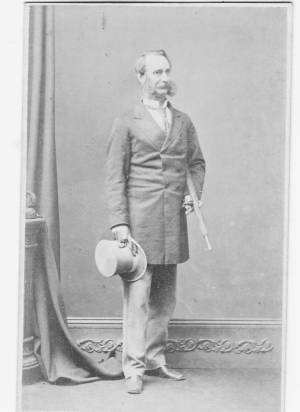
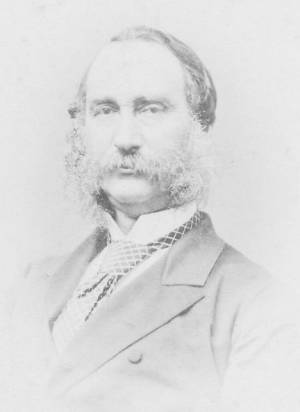
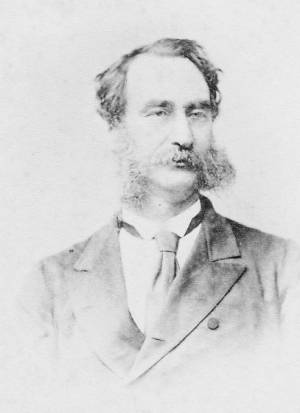 The first two photos from TLM-P's album13) were taken in Melbourne; the last in Sydney. The images are designed to reveal a prosperous man who has succeeded in his adopted land. For more photos of him, click on TLM-P photographs. In 1882, he recorded that his trip to England had resulted in him putting on weight and when he weighed himself a bit later he was 12 stone 7 or 8 lbs.14)
The first two photos from TLM-P's album13) were taken in Melbourne; the last in Sydney. The images are designed to reveal a prosperous man who has succeeded in his adopted land. For more photos of him, click on TLM-P photographs. In 1882, he recorded that his trip to England had resulted in him putting on weight and when he weighed himself a bit later he was 12 stone 7 or 8 lbs.14)
Furniture and other possessions
The beautiful furniture that TLM-P owned reveals that he shared his father's tastes for fine art and household items. It also supports the interpretation that TLM-P was motivated by his determination to restore his family's gentry status. The next photo is of his intricately carved Italian cabinet,15) the twin of which is in Brisbane's Tattersalls Club. It is said to have been imported to Australia by the Italian architect Mr Andrea Strombuco in c. 1885 for his home in Albion. As this cabinet is identical, and TLM-P also lived in Albion, it is assumed that it too was also imported by Senior Strombuco.16) As usual with such furniture, it neatly comes into sections:
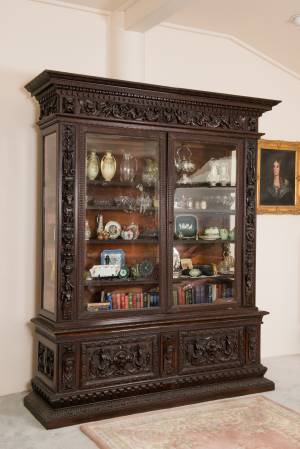
This Chest with mirror belonged to Thomas B. and Lizzie M-P.17)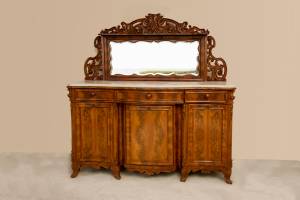
The family has numerous examples of Australian red cedar furniture which has been passed on through the generations from TLM-P and his family. This elegant table with chairs is one example.18)
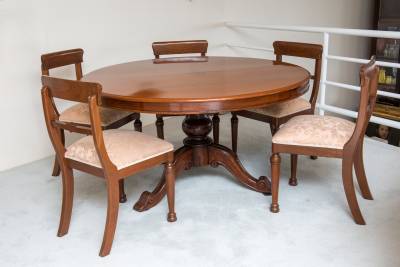
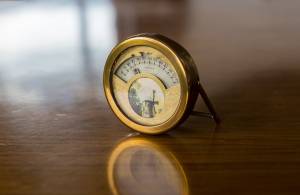 A very different watch, made in France[check?], and thought to have belonged to TLM-P.19)
A very different watch, made in France[check?], and thought to have belonged to TLM-P.19)
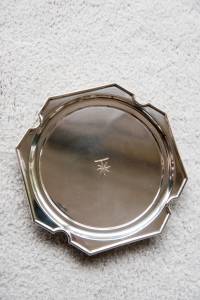 TLM-P, once he had his family's entitlement to arms cleared, had his silver engraved. This plate is an example.20)
TLM-P, once he had his family's entitlement to arms cleared, had his silver engraved. This plate is an example.20)
As well, a number of paintings, apart from family portraits and paintings of Maroon and district, came down the family line and were reputed to be TLM-P's. They include the following:
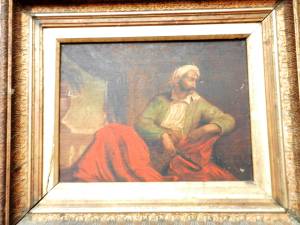 21)
21)
The following is a black and white photo of the original.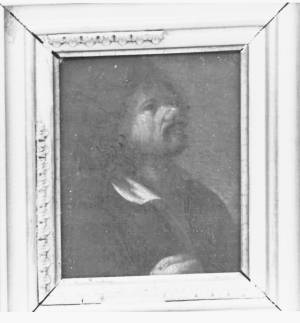
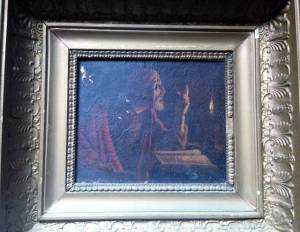 22)
22) 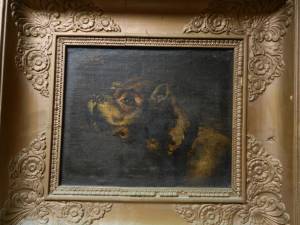 23)
23)
Nora's or Thomas Lodge's?
The following three Swiss scenes were possibility purchased as souvenirs when Nora lived for a while in Switzerland before permanently moving to England. The first is of a famous waterfall seen on the way to Jungfrau.24)
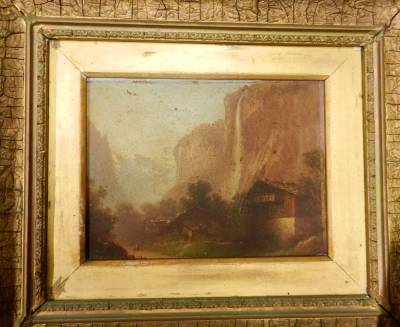
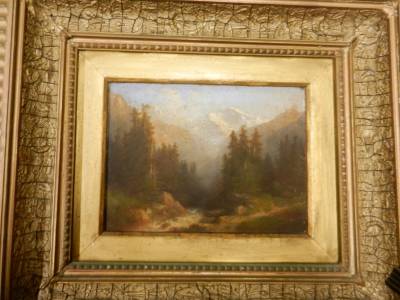
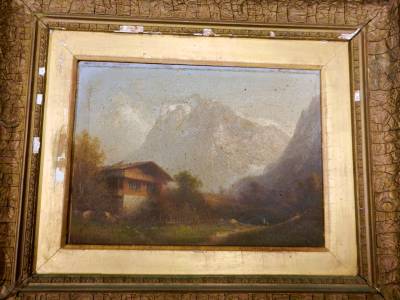
Colonial Masculinity
A much more problematic aspect of TLM-P's career is the connection between nineteenth century masculinity, the brutal takeover of aboriginal lands, and the colonial imperative to (as it was later put) 'populate or perish'. Nineteenth century Queensland was relatively isolated and sparsely populated by whites, so settlers like TLM-P idealised the land as 'vast uninhabited stretches of country waiting to be filled by resolute, hardworking Britons … Progress - conceived in the masculinist framework of aggressive expansion, ruthless destruction of the Aboriginal people, economic development and environmental exploitation - needed not only capital, brawn and sheer determination to succeed, but healthy young citizens'.25)
Historian Angela Woollacott has argued, using TLM-P as a case study, that the concept of manhood in the colonies was intertwined with acceptance of frontier violence. She unquestioningly accepts Rosa Praed's version of events despite Rosa never quite making the transition from being a novelist to that of an accurate memoirist. She also attributes TLM-P's memoir of the Hornett Bank massacre to Rosa. Nevertheless, her argument, supported by other historians, is worth considering: that 'frontier violence was accepted within evolving definitions of manhood and hence political responsibility … when we link frontier violence to gendered authority, mid-nineteenth century ideas of manhood might look a little less peaceable and restrained'.26)
TLM-P was too complicated to be a satisfactory stock figure in any historical argument, though it would be possible to mount a case that his identification with royalty, insistence on a 'courtly' bearing and even his art collection that he bequeathed to the public, was at least partly motivated by a desire to assert himself as a civilised man, and to distance himself from his part in the grim reality of wrenching land from its traditional owners.
His diaries, as well as his friendship with Leichhardt, reveal his intense scientific and philosophical curiosity. When he London in 1882, he got chatting to a Salvation Army officer, commenting that Meta, then 9 years old, had asked, 'Why God let the Devil make her bad!' TLM-P told the officer that he this and other tricky questions should be honestly tackled by clergyman rather than the issue being dismissed with an exhortion to have faith.((TLM-P, Diary, 14 June 1882